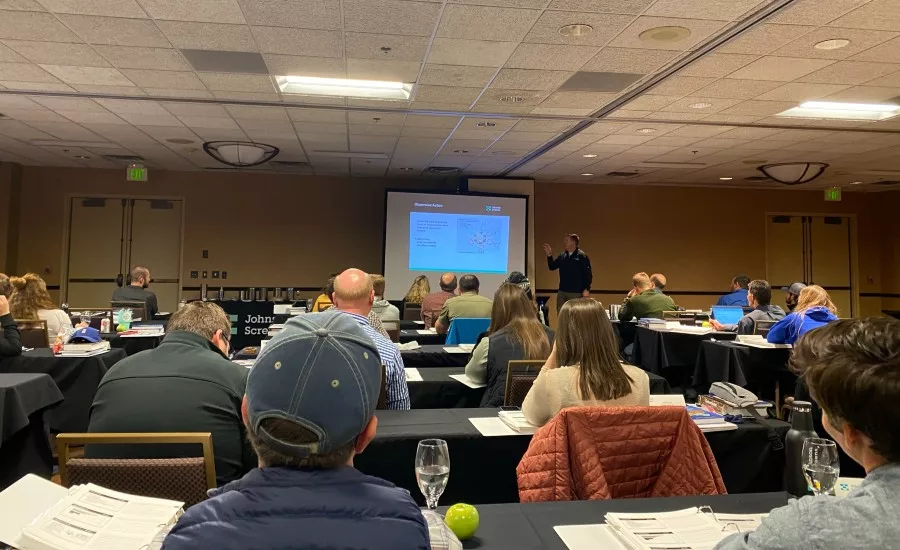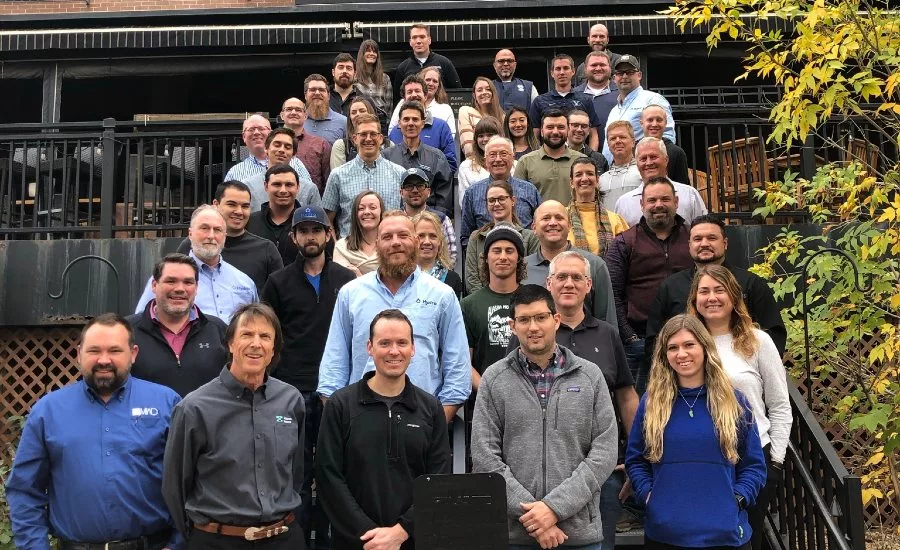Training Brings Drillers, Scientists, Engineers all to One Table
A Cross-Discipline Approach from ‘Groundwater & Wells’ Authors

Presentations at the “Groundwater & Wells” training covered everything from siting to fluids, and materials to maintenance.
Source: Brock Yordy

Attendees included a full roster of water well stakeholders, including drillers, engineers, scientists and owners.
Source: Brock Yordy

The training featured contributions from authors and experts responsible for some of the iconic resources in the water well industry.
Source: Brock Yordy
One of my favorite quotes in the groundwater industry is, “Creating a water well is as much art as it is science.” The genius of that saying? Many pieces of great art and the most significant scientific discoveries came through collaboration. Creating a water well is no different.
Pathways to completion require the artist — that is, “the driller” — and scientists to work together. When they reach the right balance of art and science through collaboration, success follows. However, sometimes that collaboration requires a road map. For many, including me, that guide is “Groundwater & Wells” from Johnson Screens. I have seen copies of this book on drilling projects around the world. Many industry colleagues love to brag that they own all three editions. “Groundwater & Wells” embraces the collaborative spirit by compiling industry best practices with opinions on creating productive, long-lasting water wells.
Guided Tour
In October, I found something better than actually getting your hands on a dog-eared copy: a guided tour through construction by the featured authors of “Groundwater & Wells” 3rd edition. The three-day workshop took 50 groundwater professionals on a hike through the design, execution and completion of large-capacity water wells. However, the journey did not stop with well completion. It continued up the mountain to expectations of well ownership, operation and maintenance throughout the well’s lifecycle.
Not Your Grandfather’s Water Well Class
These problem-solving sessions opened up great questions, discussions and debates from attendees, who included drillers, geologists, hydrogeologists, engineers, manufacturers, water well operators and well owners.
Beyond the standard lecture approach of a three-day class, the “Groundwater & Wells” workshop posed several problems for the class to critically discuss and solve along the way. These problem-solving sessions opened up great questions, discussions and debates from attendees, who included drillers, geologists, hydrogeologists, engineers, manufacturers, water well operators and well owners. These discussions led us toward our final project, designing “The Coolville Well.” It was refreshing to share insight with and experience different points of view from other attendees and the speakers.
Designed Well
Our industry makes it a goal to create the most reliable water wells possible. However, reliability depends on the information gathering through exploration. During the workshop, the authors emphasized the importance of gathering all the data to determine well reliability. On day one, Dr. Robert Sterrett drove home the importance of reliability by discussing the importance of where the water comes from during pumping. Next, Thom Hanna, P.G., guided the class through choosing the best well site using exploration and sample recovery. As the first day continued, we further discussed data exploration with borehole geophysics. Finally, we wrapped the day discussing drilling methods, design considerations and well completion. Although I have been fortunate to drill around the world, which has allowed me some great experience, the first day of “Groundwater & Wells” changed my approach and perspective to the collaboration of designing a well.
Lessons Learned from Industry Legends!
The second day of the workshop focused on well construction and how it affects well development, ultimately impacting the performance of the well. It started with an impromptu mini mud school by author Fred Rothauge. Rothauge, a global expert in drilling, completions and well rehabilitation, taught the drilling methods, drilling fluids, and well construction portion of the workshop. He took the class through the complete mud testing procedures and discussed the importance of maintaining good fluids properties. Rothauge and Hanna collaborate on complex projects around the world.
After cleaning up the spilled mud, Mike Mehmert, consulting hydrogeologist for Johnson Screens, taught us the importance of well material types, manufacturing processes, tolerances and strengths. Later, Hanna taught the development phase and Sterrett shared insight on well efficiency and pump testing. We ended the day with pump guru Robert Prichard giving us real-world pump, motor and controls lessons. It was an incredible day full of lessons learned and valuable discussions that should happen more often in our industry.
Operational Stages of a Well
Often for drillers, our final chapter is well completion with maybe a couple of rehabilitation short stories. However, as the “Groundwater & Wells” book closed, an entirely new book opens titled “Operational Stage of the Well.” The final day of the workshop focused on how to determine the lifecycle of the well. First, Michael Schnieders, hydrogeologist and president of Water Systems Engineering, took us on an incredible tour of chemical changes in wells. He taught us how to seek out specific parameters to monitor and when those specifics change the impact. Schnieders also brilliantly outlined the impact of microorganisms in a well.
Next, we learned from Prichard how pump and motor efficiency affect the operational cost of the well. Finally, we jumped into evaluation, diagnosis, troubleshooting and rehabilitation plans taught by Hanna, Rothauge and Schnieders. Finally, we wrapped the day with a discussion led by Hanna on the economics of the well and lessons learned.
The three-day workshop was an incredible opportunity to learn with other groundwater professionals and the authors. We entered day one as industry colleagues/strangers, and left on day three as friends. The groundwater industry all too often creates professional development silos where engineers, scientists, owners and drillers learn within their own groups. The only time we learn together is in the middle of a high-stakes project. The best part of the three-day program was having a cross-section of all parties involved in the well’s lifecycle guiding us to the best practice of working together. We started the workshop with a proposed hypothetical problem of adequately designing the Coolville Well for the best efficiency and life. In the end, my classmates and I learned how to solve a real problem: how to better collaborate through the lifecycle of a well and our careers.
Looking for a reprint of this article?
From high-res PDFs to custom plaques, order your copy today!









